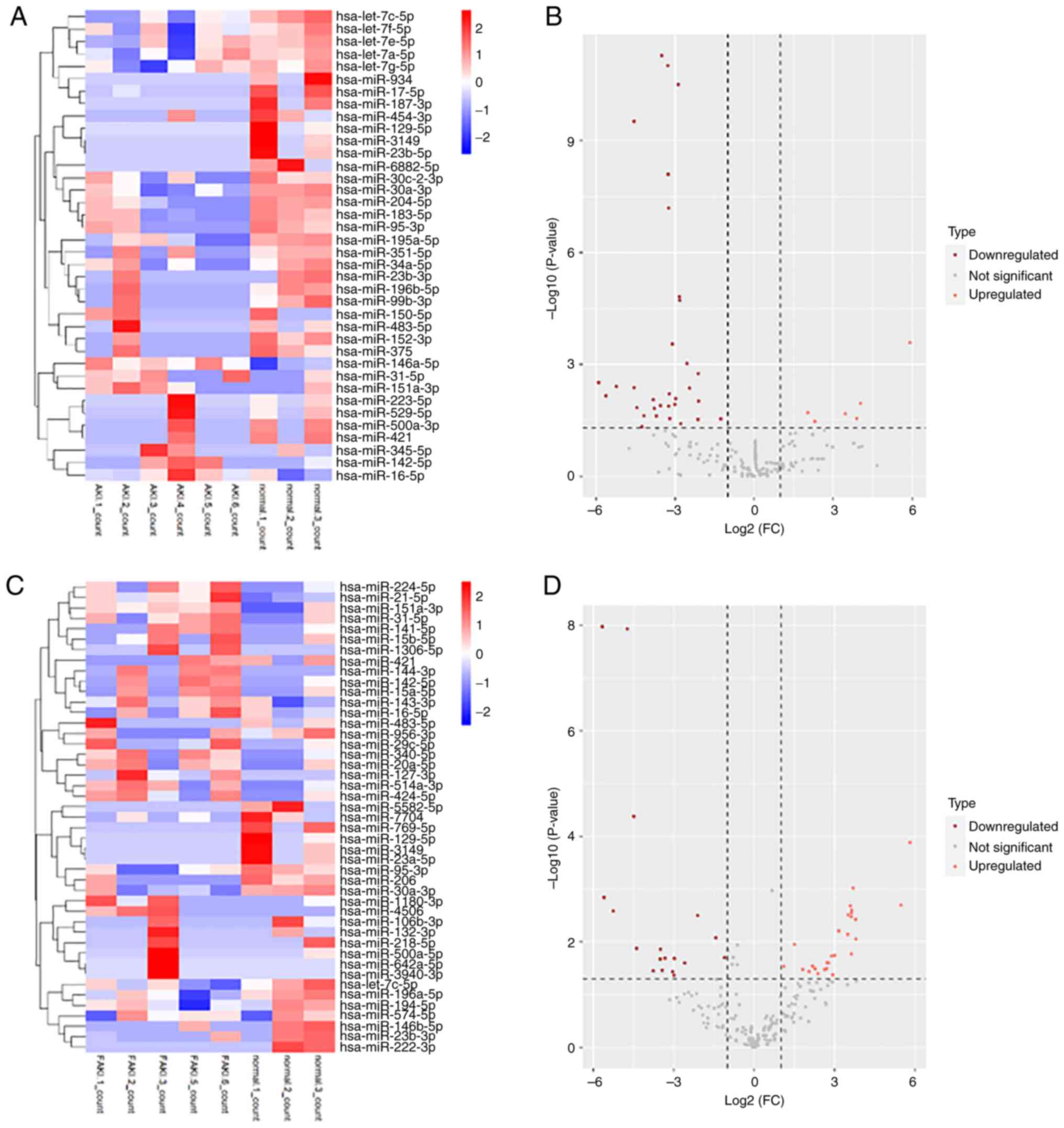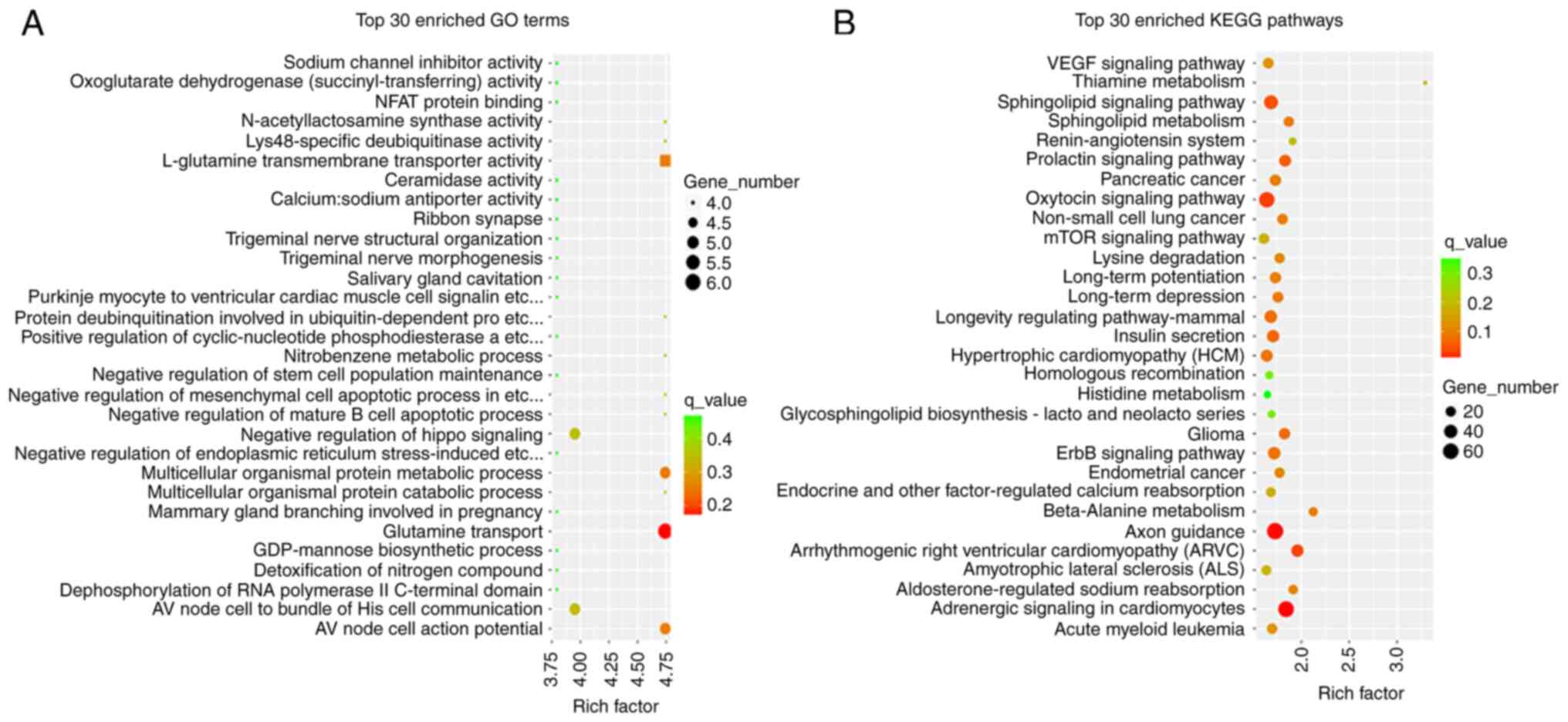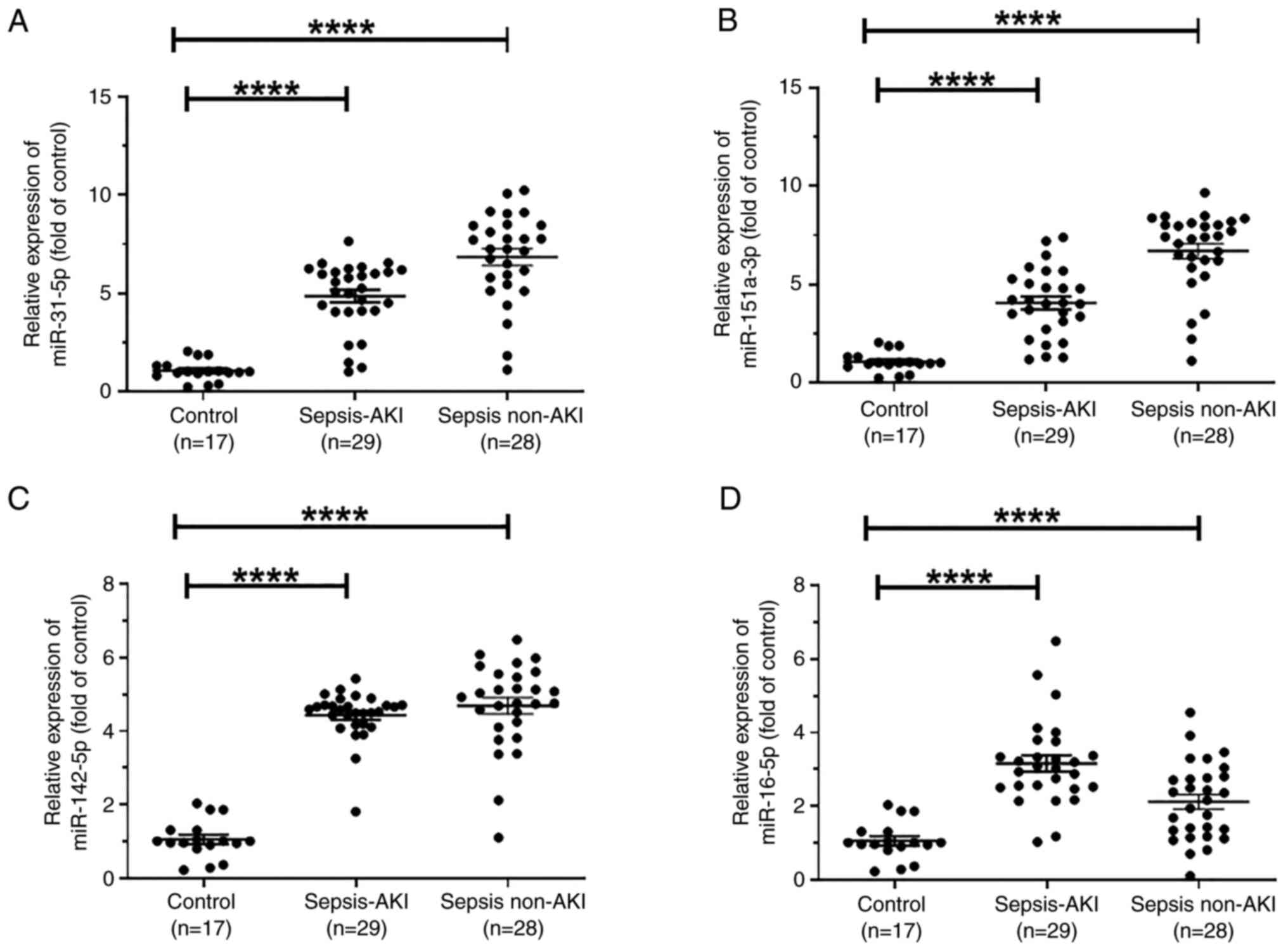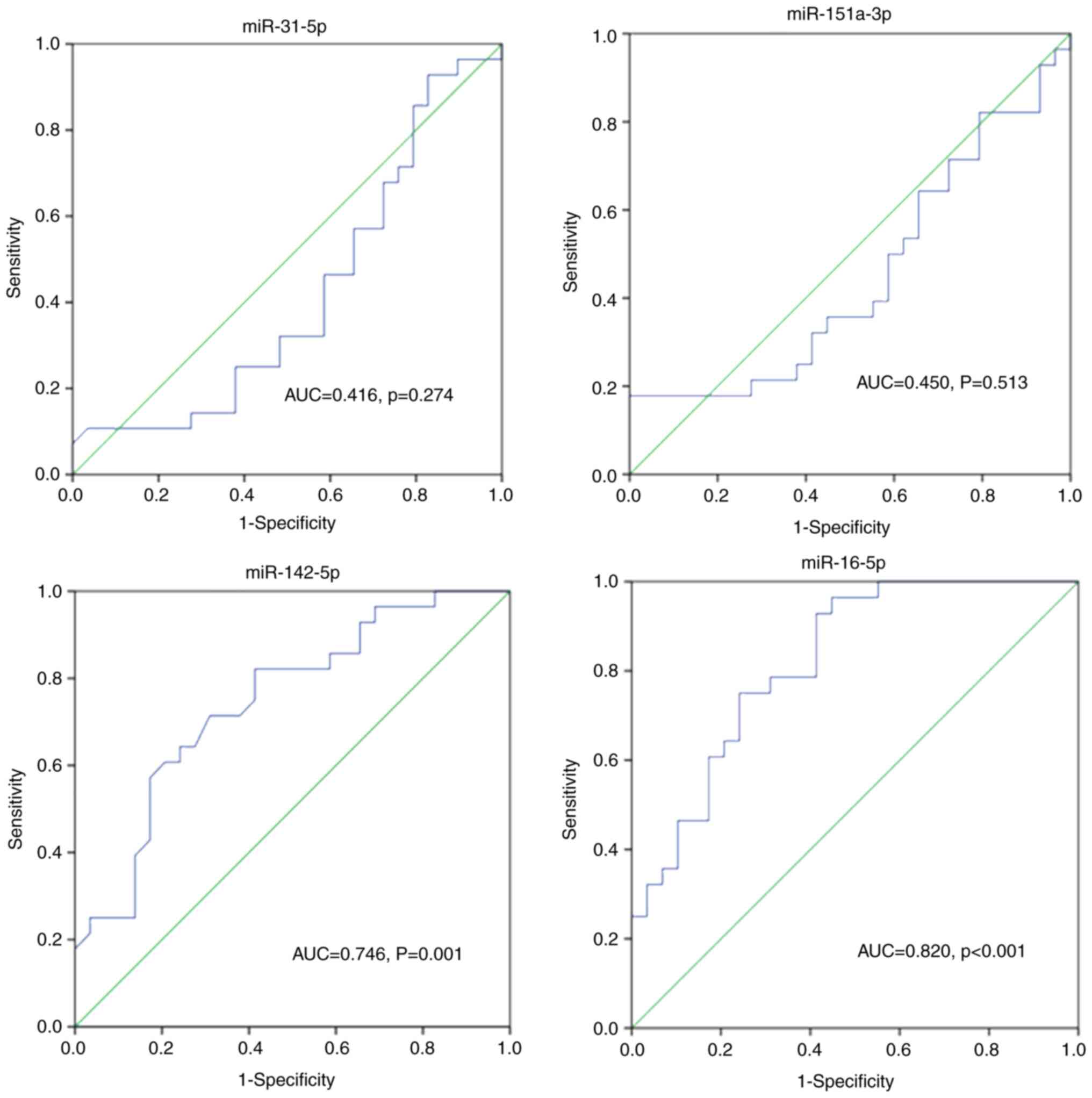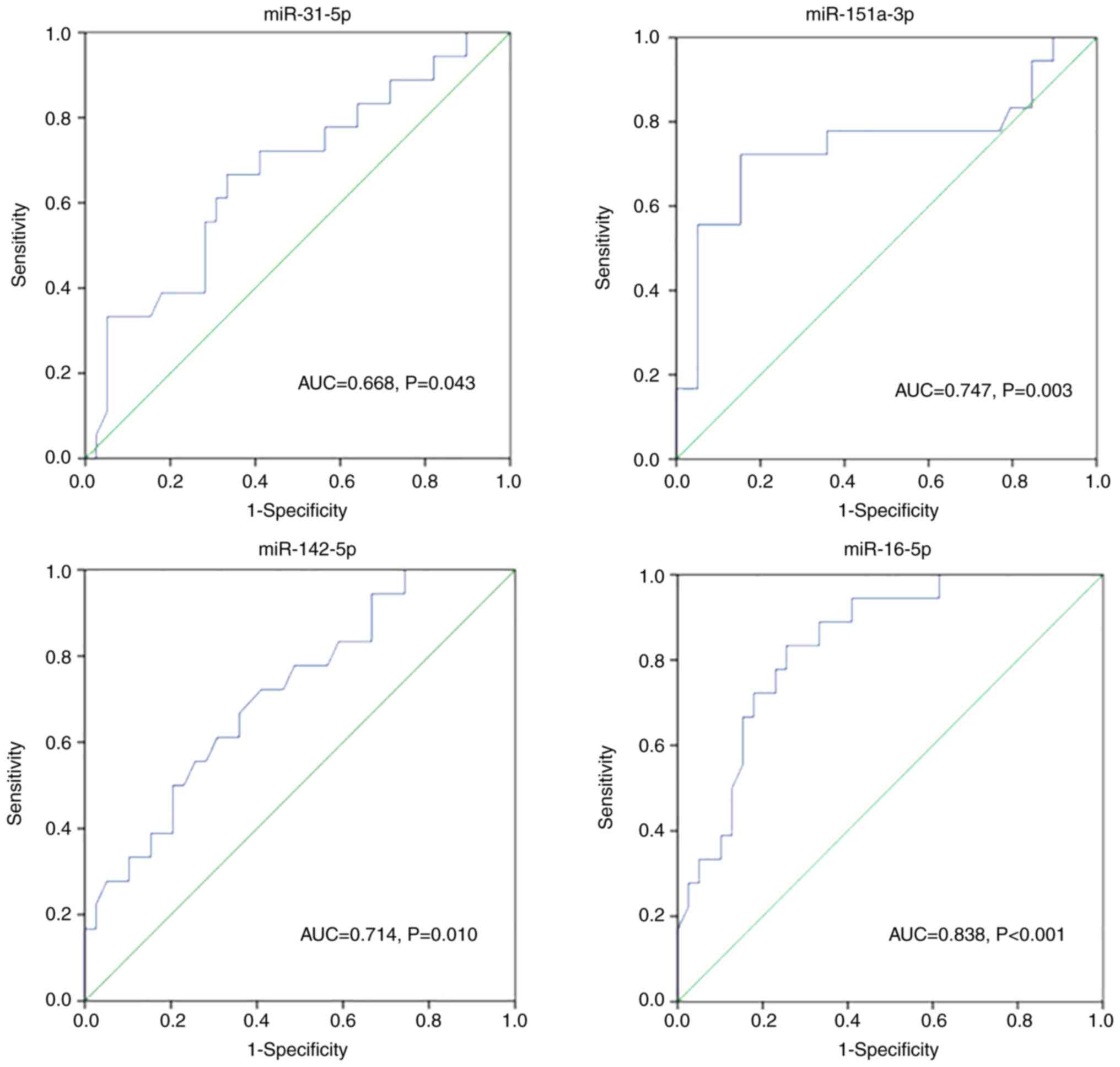|
1
|
Rudd KE, Johnson SC, Agesa KM, Shackelford
KA, Tsoi D, Kievlan DR, Colombara DV, Ikuta KS, Kissoon N, Finfer
S, et al: Global, regional, and national sepsis incidence and
mortality, 1990-2017: Analysis for the global burden of disease
study. Lancet. 395:200–211. 2020.PubMed/NCBI View Article : Google Scholar
|
|
2
|
Singer M, Deutschman CS, Seymour CW,
Shankar-Hari M, Annane D, Bauer M, Bellomo R, Bernard GR, Chiche
JD, Coopersmith CM, et al: The third international consensus
definitions for sepsis and septic shock (sepsis-3). JAMA.
315:801–810. 2016.PubMed/NCBI View Article : Google Scholar
|
|
3
|
Cerceo E, Rachoin JS, Gaughan J and
Weisberg L: Association of gender, age, and race on renal outcomes
and mortality in patients with severe sepsis and septic shock. J
Crit Care. 61:52–56. 2021.PubMed/NCBI View Article : Google Scholar
|
|
4
|
Chinai B, Gaughan J and Schorr C:
Implementation of the affordable care Act: A comparison of outcomes
in patients with severe sepsis and septic shock using the national
inpatient sample. Crit Care Med. 48:783–789. 2020.PubMed/NCBI View Article : Google Scholar
|
|
5
|
Gong Y, Li D, Cheng B, Ying B and Wang B:
Increased neutrophil percentage-to-albumin ratio is associated with
all-cause mortality in patients with severe sepsis or septic shock.
Epidemiol Infect. 148(e87)2020.PubMed/NCBI View Article : Google Scholar
|
|
6
|
Gazmuri RJ, Añez de Gomez CI, Siddiqui M,
Schechtman J and Nadeem AUR: Severe sepsis and septic shock early
management bundle risks aiding vasopressor misuse. Crit Care Med.
47(e717)2019.PubMed/NCBI View Article : Google Scholar
|
|
7
|
Shankar-Hari M, Phillips GS, Levy ML,
Seymour CW, Liu VX, Deutschman CS, Angus DC, Rubenfeld GD and
Singer M: Sepsis Definitions Task Force. Developing a new
definition and assessing new clinical criteria for septic shock:
For the third international consensus definitions for sepsis and
septic shock (sepsis-3). JAMA. 315:775–787. 2016.PubMed/NCBI View Article : Google Scholar
|
|
8
|
Angus DC, Seymour CW, Coopersmith CM,
Deutschman CS, Klompas M, Levy MM, Martin GS, Osborn TM, Rhee C and
Watson RS: A framework for the development and interpretation of
different sepsis definitions and clinical criteria. Crit Care Med.
44:e113–e121. 2016.PubMed/NCBI View Article : Google Scholar
|
|
9
|
Chang JC: Sepsis and septic shock:
Endothelial molecular pathogenesis associated with vascular
microthrombotic disease. Thromb J. 17(10)2019.PubMed/NCBI View Article : Google Scholar
|
|
10
|
Wang T, Zhang X, Liu Z, Yao T, Zheng D,
Gan J, Yu S, Li L, Chen P and Sun J: Single-cell RNA sequencing
reveals the sustained immune cell dysfunction in the pathogenesis
of sepsis secondary to bacterial pneumonia. Genomics.
113:1219–1233. 2021.PubMed/NCBI View Article : Google Scholar
|
|
11
|
Hashemian SM, Pourhanifeh MH, Fadaei S,
Velayati AA, Mirzaei H and Hamblin MR: Non-coding RNAs and
exosomes: Their role in the pathogenesis of sepsis. Mol Ther
Nucleic Acids. 21:51–74. 2020.PubMed/NCBI View Article : Google Scholar
|
|
12
|
Sungurlu S, Kuppy J and Balk RA: Role of
antithrombin III and tissue factor pathway in the pathogenesis of
sepsis. Crit Care Clin. 36:255–265. 2020.PubMed/NCBI View Article : Google Scholar
|
|
13
|
Zhang H, Feng YW and Yao YM: A profound
understanding of the pathogenesis network in sepsis. Zhonghua Yi
Xue Za Zhi. 100:881–885. 2020.PubMed/NCBI View Article : Google Scholar : (In Chinese).
|
|
14
|
Shenoy S: Coronavirus (Covid-19) sepsis:
Revisiting mitochondrial dysfunction in pathogenesis, aging,
inflammation, and mortality. Inflamm Res. 69:1077–1085.
2020.PubMed/NCBI View Article : Google Scholar
|
|
15
|
Nie C, Qian KJ, Wang LQ, Liu F, Zeng ZG,
Zhu F, Xia L and Zhan YA: A clinical study on organ protective
effect of early high-volume hemofiltration (HVHF) in patients with
multiple organ dysfunction syndrome (MODS) complicated by acute
kidney injury (AKI). Zhongguo Wei Zhong Bing Ji Jiu Yi Xue.
23:605–607. 2011.PubMed/NCBI(In Chinese).
|
|
16
|
Erlanger D, Assous MV, Wiener-Well Y,
Yinnon AM and Ben-Chetrit E: Clinical manifestations, risk factors
and prognosis of patients with Morganella morganii sepsis. J
Microbiol Immunol Infect. 52:443–448. 2019.PubMed/NCBI View Article : Google Scholar
|
|
17
|
Kasahara E and Inoue M: Cross-talk between
HPA-axis-increased glucocorticoids and mitochondrial stress
determines immune responses and clinical manifestations of patients
with sepsis. Redox Rep. 20:1–10. 2015.PubMed/NCBI View Article : Google Scholar
|
|
18
|
El-Hefnawy SM, Mostafa RG, El Zayat RS,
Elfeshawy EM, Abd El-Bari HM and El-Monem Ellaithy MA: Biochemical
and molecular study on serum miRNA-16a and miRNA-451 as neonatal
sepsis biomarkers. Biochem Biophys Rep. 25(100915)2021.PubMed/NCBI View Article : Google Scholar
|
|
19
|
Fabri-Faja N, Calvo-Lozano O, Dey P,
Terborg RA, Estevez MC, Belushkin A, Yesilköy F, Duempelmann L,
Altug H, Pruneri V and Lechuga LM: Early sepsis diagnosis via
protein and miRNA biomarkers using a novel point-of-care photonic
biosensor. Anal Chim Acta. 1077:232–242. 2019.PubMed/NCBI View Article : Google Scholar
|
|
20
|
Li Z, Huang B, Yi W, Wang F, Wei S, Yan H,
Qin P, Zou D, Wei R and Chen N: Identification of potential early
diagnostic biomarkers of sepsis. J Inflamm Res. 14:621–631.
2021.PubMed/NCBI View Article : Google Scholar
|
|
21
|
Kyriazopoulou E, Poulakou G and
Giamarellos-Bourboulis EJ: Biomarkers in sepsis: Can they help
improve patient outcome? Curr Opin Infect Dis. 34:126–134.
2021.PubMed/NCBI View Article : Google Scholar
|
|
22
|
Zhang M, Xie M, Wang Y, Li J and Zhou J:
Combination value of biomarkers in discriminating adult onset
Still's disease and sepsis. Wien Klin Wochenschr. 133:118–122.
2021.PubMed/NCBI View Article : Google Scholar
|
|
23
|
Poston JT and Koyner JL: Sepsis associated
acute kidney injury. BMJ. 364(k4891)2019.PubMed/NCBI View Article : Google Scholar
|
|
24
|
Hoste EA, Bagshaw SM, Bellomo R, Cely CM,
Colman R, Cruz DN, Edipidis K, Forni LG, Gomersall CD, Govil D, et
al: Epidemiology of acute kidney injury in critically ill patients:
The multinational AKI-EPI study. Intensive Care Med. 41:1411–1423.
2015.PubMed/NCBI View Article : Google Scholar
|
|
25
|
Fabbian F, Savriè C, De Giorgi A,
Cappadona R, Di Simone E, Boari B, Storari A, Gallerani M and
Manfredini R: Acute kidney injury and in-hospital mortality: A
retrospective analysis of a nationwide administrative database of
elderly subjects in Italy. J Clin Med. 8(1371)2019.PubMed/NCBI View Article : Google Scholar
|
|
26
|
Bagshaw SM, Uchino S, Bellomo R, Morimatsu
H, Morgera S, Schetz M, Tan I, Bouman C, Macedo E, Gibney N, et al:
Septic acute kidney injury in critically ill patients: Clinical
characteristics and outcomes. Clin J Am Soc Nephrol. 2:431–439.
2007.PubMed/NCBI View Article : Google Scholar
|
|
27
|
Vasilescu C, Dragomir M, Tanase M, Giza D,
Purnichescu-Purtan R, Chen M, Yeung SJ and Calin GA: Circulating
miRNAs in sepsis-A network under attack: An in-silico prediction of
the potential existence of miRNA sponges in sepsis. PLoS One.
12(e0183334)2017.PubMed/NCBI View Article : Google Scholar
|
|
28
|
Dumache R, Rogobete AF, Bedreag OH,
Sarandan M, Cradigati AC, Papurica M, Dumbuleu CM, Nartita R and
Sandesc D: Use of miRNAs as biomarkers in sepsis. Anal Cell Pathol
(Amst). 2015(186716)2015.PubMed/NCBI View Article : Google Scholar
|
|
29
|
Ahmad S, Ahmed MM, Hasan PMZ, Sharma A,
Bilgrami AL, Manda K, Ishrat R and Syed MA: Identification and
validation of potential miRNAs, as biomarkers for sepsis and
associated lung injury: A network-based approach. Genes (Basel).
11(1327)2020.PubMed/NCBI View Article : Google Scholar
|
|
30
|
Zhang Y, Li M, Bao L and Hu P: A
case-control study on the relationship between miRNAs single
nucleotide polymorphisms and sepsis risk. Medicine (Baltimore).
98(e16744)2019.PubMed/NCBI View Article : Google Scholar
|
|
31
|
Reinhart K and Carlet J: Procalcitonin-a
new marker of severe infection and sepsis. Intensive Care Med. 26
(Suppl 2)(S145)2000.PubMed/NCBI View Article : Google Scholar
|
|
32
|
Stark A, Brennecke J, Russell RB and Cohen
SM: Identification of Drosophila MicroRNA targets. PLoS Biol.
1(E60)2003.PubMed/NCBI View Article : Google Scholar
|
|
33
|
Xu P, Vernooy SY, Guo M and Hay BA: The
Drosophila microRNA Mir-14 suppresses cell death and is required
for normal fat metabolism. Curr Biol. 13:790–795. 2003.PubMed/NCBI View Article : Google Scholar
|
|
34
|
Jeker LT and Bluestone JA: MicroRNA
regulation of T-cell differentiation and function. Immunol Rev.
253:65–81. 2013.PubMed/NCBI View Article : Google Scholar
|
|
35
|
Mitchell PS, Parkin RK, Kroh EM, Fritz BR,
Wyman SK, Pogosova-Agadjanyan EL, Peterson A, Noteboom J, O'Briant
KC, Allen A, et al: Circulating microRNAs as stable blood-based
markers for cancer detection. Proc Natl Acad Sci USA.
105:10513–10518. 2008.PubMed/NCBI View Article : Google Scholar
|
|
36
|
Pigati L, Yaddanapudi SC, Iyengar R, Kim
DJ, Hearn SA, Danforth D, Hastings ML and Duelli DM: Selective
release of microRNA species from normal and malignant mammary
epithelial cells. PLoS One. 5(e13515)2010.PubMed/NCBI View Article : Google Scholar
|
|
37
|
Mir R, Elfaki I, Khullar N, Waza AA, Jha
C, Mir MM, Nisa S, Mohammad B, Mir TA, Maqbool M, et al: Role of
selected miRNAs as diagnostic and prognostic biomarkers in
cardiovascular diseases, including coronary artery disease,
myocardial infarction and atherosclerosis. J Cardiovasc Dev Dis.
8(22)2021.PubMed/NCBI View Article : Google Scholar
|
|
38
|
Gessner I, Fries JWU, Brune V and Mathur
S: Magnetic nanoparticle-based amplification of microRNA detection
in body fluids for early disease diagnosis. J Mater Chem B. 9:9–22.
2021.PubMed/NCBI View Article : Google Scholar
|
|
39
|
Demircan T, Sibai M, Avşaroğlu ME,
Altuntaş E and Ovezmyradov G: The first report on circulating
microRNAs at Pre- and Post-metamorphic stages of axolotls. Gene.
768(145258)2021.PubMed/NCBI View Article : Google Scholar
|
|
40
|
Tan PPS, Hall D, Chilian WM, Chia YC, Mohd
Zain S, Lim HM, Kumar DN, Ching SM, Low TY, Md Noh MF and Pung YF:
Exosomal microRNAs in the development of essential hypertension and
its potential as biomarkers. Am J Physiol Heart Circ Physiol.
320:H1486–H1497. 2021.PubMed/NCBI View Article : Google Scholar
|
|
41
|
Cui C and Cui Q: The relationship of human
tissue microRNAs with those from body fluids. Sci Rep.
10(5644)2020.PubMed/NCBI View Article : Google Scholar
|
|
42
|
Harrill AH and Sanders AP: Urinary
MicroRNAs in environmental health: Biomarkers of emergent kidney
injury and disease. Curr Environ Health Rep. 7:101–108.
2020.PubMed/NCBI View Article : Google Scholar
|
|
43
|
Dos Santos CC, Amatullah H, Vaswani CM,
Maron-Gutierrez T, Kim M, Mei SHJ, Szaszi K, Monteiro APT, Varkouhi
AK, Herreroz R, et al: Mesenchymal stromal (stem) cell therapy
modulates miR-193b-5p expression to attenuate sepsis-induced acute
lung injury. Eur Respir J. 59(2004216)2022.PubMed/NCBI View Article : Google Scholar
|
|
44
|
Jiao Y, Zhang T, Zhang C, Ji H, Tong X,
Xia R, Wang W, Ma Z and Shi X: Exosomal miR-30d-5p of neutrophils
induces M1 macrophage polarization and primes macrophage pyroptosis
in sepsis-related acute lung injury. Crit Care.
25(356)2021.PubMed/NCBI View Article : Google Scholar
|
|
45
|
Roderburg C, Luedde M, Vargas Cardenas D,
Vucur M, Scholten D, Frey N, Koch A, Trautwein C, Tacke F and
Luedde T: Circulating microRNA-150 serum levels predict survival in
patients with critical illness and sepsis. PLoS One.
8(e54612)2013.PubMed/NCBI View Article : Google Scholar
|
|
46
|
Roderburg C, Koch A, Benz F, Vucur M,
Spehlmann M, Loosen SH, Luedde M, Rehse S, Lurje G, Trautwein C, et
al: Serum levels of miR-143 predict survival in critically Ill
patients. Dis Markers. 2019(4850472)2019.PubMed/NCBI View Article : Google Scholar
|
|
47
|
Han Y, Dai QC, Shen HL and Zhang XW:
Diagnostic value of elevated serum miRNA-143 levels in sepsis. J
Int Med Res. 44:875–881. 2016.PubMed/NCBI View Article : Google Scholar
|
|
48
|
Zhu C, Chen T and Liu B: Inhibitory
effects of miR-25 targeting HMGB1 on macrophage secretion of
inflammatory cytokines in sepsis. Oncol Lett. 16:5027–5033.
2018.PubMed/NCBI View Article : Google Scholar
|
|
49
|
Moon HG, Yang J, Zheng Y and Jin Y:
miR-15a/16 regulates macrophage phagocytosis after bacterial
infection. J Immunol. 193:4558–4567. 2014.PubMed/NCBI View Article : Google Scholar
|
|
50
|
Wang X, Wang X, Liu X, Wang X, Xu J, Hou
S, Zhang X and Ding Y: miR-15a/16 are upreuglated in the serum of
neonatal sepsis patients and inhibit the LPS-induced inflammatory
pathway. Int J Clin Exp Med. 8:5683–5690. 2015.PubMed/NCBI
|
|
51
|
Arroyo AB, Águila S, Fernández-Pérez MP,
Reyes-García AML, Reguilón-Gallego L, Zapata-Martínez L, Vicente V,
Martínez C and González-Conejero R: miR-146a in cardiovascular
diseases and sepsis: An additional burden in the inflammatory
balance? Thromb Haemost. 121:1138–1150. 2021.PubMed/NCBI View Article : Google Scholar
|
|
52
|
Pfeiffer D, Roßmanith E, Lang I and
Falkenhagen D: miR-146a, miR-146b, and miR-155 increase expression
of IL-6 and IL-8 and support HSP10 in an in vitro sepsis model.
PLoS One. 12(e0179850)2017.PubMed/NCBI View Article : Google Scholar
|
|
53
|
Bai X, Zhang J, Cao M, Han S, Liu Y, Wang
K, Han F, Li X, Jia Y, Wang X, et al: MicroRNA-146a protects
against LPS-induced organ damage by inhibiting Notch1 in
macrophage. Int Immunopharmacol. 63:220–226. 2018.PubMed/NCBI View Article : Google Scholar
|
|
54
|
Möhnle P, Hirschberger S, Hinske LC,
Briegel J, Hübner M, Weis S, Dimopoulos G, Bauer M,
Giamarellos-Bourboulis EJ and Kreth S: MicroRNAs 143 and 150 in
whole blood enable detection of T-cell immunoparalysis in sepsis.
Mol Med. 24(54)2018.PubMed/NCBI View Article : Google Scholar
|
|
55
|
SepNet Critical Care Trials Group.
Incidence of severe sepsis and septic shock in German intensive
care units: The prospective, multicentre INSEP study. Intensive
Care Med. 42:1980–1989. 2016.PubMed/NCBI View Article : Google Scholar
|
|
56
|
Baykara N, Akalın H, Arslantaş MK, Hancı
V, Çağlayan Ç, Kahveci F, Demirağ K, Baydemir C and Ünal N: Sepsis
Study Group. Epidemiology of sepsis in intensive care units in
Turkey: A multicenter, point-prevalence study. Crit Care.
22(93)2018.PubMed/NCBI View Article : Google Scholar
|
|
57
|
Zhou J, Qian C, Zhao M, Yu X, Kang Y, Ma
X, Ai Y, Xu Y, Liu D, An Y, et al: Epidemiology and outcome of
severe sepsis and septic shock in intensive care units in mainland
China. PLoS One. 9(e107181)2014.PubMed/NCBI View Article : Google Scholar
|
|
58
|
Mizuno T, Sato W, Ishikawa K, Shinjo H,
Miyagawa Y, Noda Y, Imai E and Yamada K: KDIGO (kidney disease:
Improving global outcomes) criteria could be a useful outcome
predictor of cisplatin-induced acute kidney injury. Oncology.
82:354–359. 2012.PubMed/NCBI View Article : Google Scholar
|
|
59
|
Livak KJ and Schmittgen TD: Analysis of
relative gene expression data using real-time quantitative PCR and
the 2(-Delta Delta C(T)) method. Methods. 25:402–408.
2001.PubMed/NCBI View Article : Google Scholar
|
|
60
|
Cui M, Cheng C and Zhang L:
High-throughput proteomics: A methodological mini-review. Lab
Invest. 102:1170–1181. 2022.PubMed/NCBI View Article : Google Scholar
|
|
61
|
Cheng H, Xu JH, Kang XH, Wu CC, Tang XN,
Chen ML, Lian ZS, Li N and Xu XL: Nomograms for predicting overall
survival and cancer-specific survival in elderly patients with
epithelial ovarian cancer. J Ovarian Res. 16(75)2023.PubMed/NCBI View Article : Google Scholar
|
|
62
|
Hegamyer E, Smith N, Thompson AD and
Depiero AD: Treatment of suspected sepsis and septic shock in
children with chronic disease seen in the pediatric emergency
department. Am J Emerg Med. 44:56–61. 2021.PubMed/NCBI View Article : Google Scholar
|
|
63
|
D'Onofrio V, Meersman A, Vijgen S,
Cartuyvels R, Messiaen P and Gyssens IC: Risk factors for
mortality, intensive care unit admission, and bacteremia in
patients suspected of sepsis at the emergency department: A
prospective cohort study. Open Forum Infect Dis.
8(ofaa594)2020.PubMed/NCBI View Article : Google Scholar
|
|
64
|
Barichello T, Generoso JS, Singer M and
Dal-Pizzol F: Biomarkers for sepsis: More than just fever and
leukocytosis-a narrative review. Crit Care. 26(14)2022.PubMed/NCBI View Article : Google Scholar
|
|
65
|
Nassar FJ, Msheik ZS, Itani MM, Helou RE,
Hadla R, Kreidieh F, Bejjany R, Mukherji D, Shamseddine A, Nasr RR
and Temraz SN: Circulating miRNA as biomarkers for colorectal
cancer diagnosis and liver metastasis. Diagnostics (Basel).
11(341)2021.PubMed/NCBI View Article : Google Scholar
|
|
66
|
Smolarz M and Widlak P: Serum exosomes and
their miRNA load-a potential biomarker of lung cancer. Cancers
(Basel). 13(1373)2021.PubMed/NCBI View Article : Google Scholar
|
|
67
|
Wang M, Zheng S, Li X, Ding Y, Zhang M,
Lin L, Xu H, Cheng Y, Zhang X, Xu H and Li S: Integrated analysis
of lncRNA-miRNA-mRNA ceRNA network identified lncRNA EPB41L4A-AS1
as a potential biomarker in non-small cell lung cancer. Front
Genet. 11(511676)2020.PubMed/NCBI View Article : Google Scholar
|
|
68
|
Liu S, Liu C, Wang Z, Huang J and Zeng Q:
microRNA-23a-5p acts as a potential biomarker for sepsis-induced
acute respiratory distress syndrome in early stage. Cell Mol Biol
(Noisy-le-grand). 62:31–37. 2016.PubMed/NCBI
|
|
69
|
Bukauskas T, Kairytė M, Mickus R,
Puleikytė L and Macas A: Values of circulating molecular biomarkers
(microRNAs) for the evaluation of renal failure during urgent
abdominal sepsis anaesthesia. Acta Med Litu. 26:17–24.
2019.PubMed/NCBI View Article : Google Scholar
|
|
70
|
Hollen MK, Stortz JA, Darden D, Dirain ML,
Nacionales DC, Hawkins RB, Cox MC, Lopez MC, Rincon JC, Ungaro R,
et al: Myeloid-derived suppressor cell function and epigenetic
expression evolves over time after surgical sepsis. Crit Care.
23(355)2019.PubMed/NCBI View Article : Google Scholar
|
|
71
|
Benz F, Roderburg C, Vargas Cardenas D,
Vucur M, Gautheron J, Koch A, Zimmermann H, Janssen J,
Nieuwenhuijsen L, Luedde M, et al: U6 is unsuitable for
normalization of serum miRNA levels in patients with sepsis or
liver fibrosis. Exp Mol Med. 45(e42)2013.PubMed/NCBI View Article : Google Scholar
|
|
72
|
Aomatsu A, Kaneko S, Yanai K, Ishii H, Ito
K, Hirai K, Ookawara S, Kobayashi Y, Sanui M and Morishita Y:
MicroRNA expression profiling in acute kidney injury. Transl Res.
244:1–31. 2022.PubMed/NCBI View Article : Google Scholar
|
|
73
|
Zhao W, Zhang Y, Zhang M, Zhi Y, Li X and
Liu X: Effects of total glucosides of paeony on acute renal injury
following ischemia-reperfusion via the lncRNA HCG18/miR-16-5p/Bcl-2
axis. Immunobiology. 227(152179)2022.PubMed/NCBI View Article : Google Scholar
|
|
74
|
Pan W, Zhang J, Hu L and Huang Z:
Evaluation value of serum miR-4299 and miR-16-5p in risk
stratification of sepsis-induced acute kidney injury. Biomed Res
Int. 2022(5165892)2022.PubMed/NCBI View Article : Google Scholar
|
|
75
|
Tang B, Li W, Ji T, Li X, Qu X, Feng L,
Zhu Y, Qi Y, Zhu C and Bai S: Downregulation of XIST ameliorates
acute kidney injury by sponging miR-142-5p and targeting PDCD4. J
Cell Physiol. 235:8852–8863. 2020.PubMed/NCBI View Article : Google Scholar
|
|
76
|
Reithmair M, Buschmann D, Märte M,
Kirchner B, Hagl D, Kaufmann I, Pfob M, Chouker A, Steinlein OK,
Pfaffl MW and Schelling G: Cellular and extracellular miRNAs are
blood-compartment-specific diagnostic targets in sepsis. J Cell Mol
Med. 21:2403–2411. 2017.PubMed/NCBI View Article : Google Scholar
|















